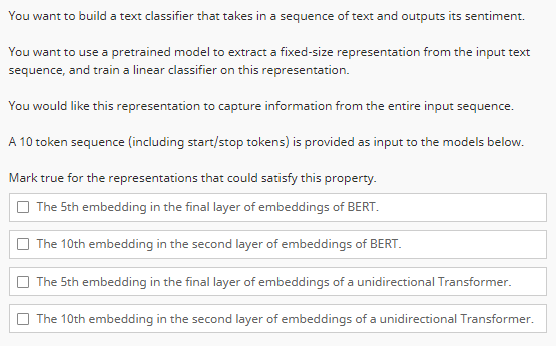You want to build a text classifier that takes in a sequence of text and outputs its sentiment. You want to use a pretrained model to extract a fixed-size representation from the input text sequence, and train a linear classifier on this representation. You would like this representation to capture information from the entire input sequence. A 10 token sequence (including start/stop tokens) is provided as input to the models below. Mark true for the representations that could satisfy this property. The 5th embedding in the final layer of embeddings of BERT. The 10th embedding in the second layer of embeddings of BERT. The 5th embedding in the final layer of embeddings of a unidirectional Transformer. The 10th embedding in the second layer of embeddings of a unidirectional Transformer.
You want to build a text classifier that takes in a sequence of text and outputs its sentiment. You want to use a pretrained model to extract a fixed-size representation from the input text sequence, and train a linear classifier on this representation. You would like this representation to capture information from the entire input sequence. A 10 token sequence (including start/stop tokens) is provided as input to the models below. Mark true for the representations that could satisfy this property. The 5th embedding in the final layer of embeddings of BERT. The 10th embedding in the second layer of embeddings of BERT. The 5th embedding in the final layer of embeddings of a unidirectional Transformer. The 10th embedding in the second layer of embeddings of a unidirectional Transformer.
Database System Concepts
7th Edition
ISBN:9780078022159
Author:Abraham Silberschatz Professor, Henry F. Korth, S. Sudarshan
Publisher:Abraham Silberschatz Professor, Henry F. Korth, S. Sudarshan
Chapter1: Introduction
Section: Chapter Questions
Problem 1PE
Related questions
Question

Transcribed Image Text:You want to build a text classifier that takes in a sequence of text and outputs its sentiment.
You want to use a pretrained model to extract a fixed-size representation from the input text
sequence, and train a linear classifier on this representation.
You would like this representation to capture information from the entire input sequence.
A 10 token sequence (including start/stop tokens) is provided as input to the models below.
Mark true for the representations that could satisfy this property.
The 5th embedding in the final layer of embeddings of BERT.
The 10th embedding in the second layer of embeddings of BERT.
The 5th embedding in the final layer of embeddings of a unidirectional Transformer.
The 10th embedding in the second layer of embeddings of a unidirectional Transformer.
Expert Solution
Step 1
Introduction
BERT:
Google created the BERT (Bidirectional Encoder Representations from Transformers) approach for natural language processing (NLP). It is a particular neural network design that is taught to comprehend and produce human language using a lot of text input. BERT is built on a sort of neural network known as the Transformer architecture, that either leverages self-attention to enable the model to pay attention to various input sequence segments while producing output.
BERT has no particular meaning in networking because it is mostly employed in the area of natural language processing.
Step by step
Solved in 3 steps

Knowledge Booster
Learn more about
Need a deep-dive on the concept behind this application? Look no further. Learn more about this topic, computer-science and related others by exploring similar questions and additional content below.Recommended textbooks for you

Database System Concepts
Computer Science
ISBN:
9780078022159
Author:
Abraham Silberschatz Professor, Henry F. Korth, S. Sudarshan
Publisher:
McGraw-Hill Education

Starting Out with Python (4th Edition)
Computer Science
ISBN:
9780134444321
Author:
Tony Gaddis
Publisher:
PEARSON

Digital Fundamentals (11th Edition)
Computer Science
ISBN:
9780132737968
Author:
Thomas L. Floyd
Publisher:
PEARSON

Database System Concepts
Computer Science
ISBN:
9780078022159
Author:
Abraham Silberschatz Professor, Henry F. Korth, S. Sudarshan
Publisher:
McGraw-Hill Education

Starting Out with Python (4th Edition)
Computer Science
ISBN:
9780134444321
Author:
Tony Gaddis
Publisher:
PEARSON

Digital Fundamentals (11th Edition)
Computer Science
ISBN:
9780132737968
Author:
Thomas L. Floyd
Publisher:
PEARSON

C How to Program (8th Edition)
Computer Science
ISBN:
9780133976892
Author:
Paul J. Deitel, Harvey Deitel
Publisher:
PEARSON

Database Systems: Design, Implementation, & Manag…
Computer Science
ISBN:
9781337627900
Author:
Carlos Coronel, Steven Morris
Publisher:
Cengage Learning

Programmable Logic Controllers
Computer Science
ISBN:
9780073373843
Author:
Frank D. Petruzella
Publisher:
McGraw-Hill Education